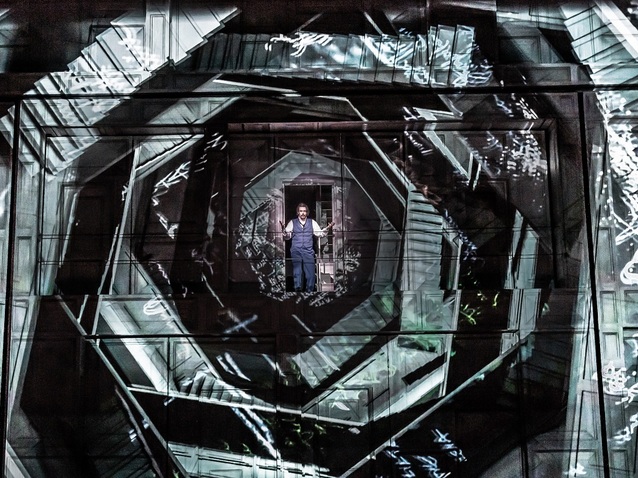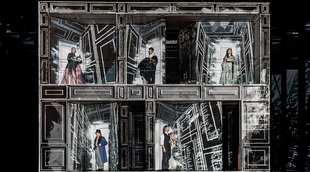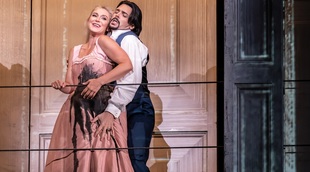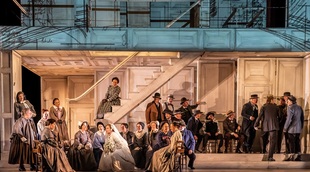 © Marc Brenner 2022
© Marc Brenner 2022
Don Giovanni of 1787 is one of three operas that Mozart wrote with the librettist Lorenzo Da Ponte (the others being Le nozze di Figaro and Così fan tutte). It tells of the eponymous hero, or rather antihero, who effortlessly conquers thousands of women. Although in the process he makes many enemies, the ladies he has cheated have a habit of coming back for more or trying to save him, and in the end he is responsible for his own downfall. When the ghost of the Commendatore who he murdered comes to dinner and invites him to repent, the Don instead chooses to live by the life he has led and consequently descends to hell.
Kasper Holten’s version, which represents a co-production with Houston Grand Opera, Israeli Opera and the Gran Teatre del Liceu, was first seen at the Royal Opera House in 2014 when he was its Director of Opera. Now revived (by Greg Eldridge) for the fifth time, including its socially distanced outing in July 2021, it has always been an intelligent production that shows a strong eye for detail and renders the social hierarchies quite subtly. For example, the Don frequently occupies a higher stage level and hence sings down to his servant Leporello, while the simple chairs at the wedding of the lowly Zerlina and Masetto contrast with the grander house behind.
The production’s concept, however, feels somewhat dictated by Es Devlin’s revolving set, which consists of a cube-shaped house with two levels that are connected by staircases. Upon this Luke Halls’s video projections appear virtually continuously throughout, and play a large part in telling the story. When the Commendatore is murdered blood ‘drips’ over the entire set, all of Don Giovanni’s former lovers are scrawled across the walls during the Overture and so-called ‘catalogue aria’, while the names of individual characters such as Donna Elvira appear on doors as if suggesting that each is destined to behave as they do. Anja Vang Kragh’s costumes tie in with the set as Donna Elvira’s dress reveals multitudinous names, while the amount of ‘ink’ that appears on Donna Anna’s pink frock varies throughout the opera in line with the idea of just how much the Don has stained her.
The difficulty that this version has always faced is that the sheer size of the set can swamp the performers and hence affect the dynamism. For example, in Act I Donna Elvira repeatedly bursts on to disrupt the Don’s plans, but when she has to do so by ascending a staircase or standing on a different level to the other protagonists, it undermines the immediacy of the action and hence the joke. Similarly in Act II when ‘Don Giovanni’ (actually Leporello in disguise) is captured by five of his mounting enemies, it hardly feels as if his life is genuinely being threatened when three of them can do no more than look down from the level above. In the final scene the starving servant appears in an entirely different place to his master, which does not help to render the requisite atmosphere as his stealing of pheasant feels practically conceptual.
The production attempts to penetrate the psychology of the drama so that, for example, the Don often appears silently before the female principals in their dreams (i.e. arias). ‘Faceless’ figures also roam the set representing the ‘ghosts’ of women who the Don has wronged and deserted, and who are now left as shadows of their former themselves.
However, one cannot help feeling that in its efforts to ‘dig deep’, the production highlights some points that are actually antithetical to what the opera is really about. When Masetto sings ‘Ho capito, signor, sì’ when Don Giovanni is striving to be left alone with Zerlina, he directs more of it to her as the Don becomes preoccupied by seeing the chilling image of the ghost of the Commendatore. Similarly, when Don Giovanni escapes from the party at the end of Act I (although in this instance he disperses everyone else rather than running himself) he is left cowering beneath the Commendatore who stands menacingly above him. However, all this suggests he has a conscience and regrets what he has done in a way that surely he does not. He may be determined not to be caught for the murder, but all his complaints about this being a terrible day result from the strife caused by his own action and Donna Elvira’s interjections, rather than any genuine feelings of guilt. If even at the opera’s end, when he is literally faced with hell, he shows no fear or remorse why would these be evident earlier?
It may seem churlish to criticise a production that deliberately sets out to explore the deterioration of Don Giovanni’s mind for doing exactly that, and it is appropriate to suggest he is a complex character who cannot be reduced to being one thing, but too much of what we see goes against the grain of what the figure is all about. Similarly, while many productions suggest that Donna Anna was complicit in the Don’s seduction of her, it is hardly believable that after realising it was him who killed her father she would disappear into a bedroom once more with him while Don Ottavio sings ‘Dalle sua pace’. True, this action may not be intended to be taken literally, but it makes too bold a statement about her character and state of mind to be credible.
This said, Luca Micheletti, with his fine baritone instrument, captures the character of Don Giovanni as this production demands him to be played perfectly. Capable of commanding the stage, his acutely observed expressions and gestures ensure he can also be the quieter, more intriguing, presence he is frequently required to be. Maria Bengtsson and Paula Murrihy give excellent performances as Donna Anna and Donna Elvira respectively. Both of their sounds could be described as full and impassioned though each comes across distinctly as befitting their different voices and characters. Charles Castronovo is superb as Don Ottavio with his gorgeous tenor really coming to the fore in ‘Dalle sua pace’ and ‘Il mio tesoro’. Christina Gansch is a beautifully sung Zerlina who also gets the character down a tee, while the cast’s two basses, Thomas Faulkner as Masetto and Adam Palka as the Commendatore, give similarly effective performances.
The highest accolades, however, go to Christopher Maltman as Leporello. He is already a highly experienced Don Giovanni, and played the role in this production in 2015, but carries off his servant with the right air of exasperation and repulsion while also displaying the most wonderful baritone sound. At times Constantin Trinks’s conducting may feel a little on the slow slide to capture some of the sweep of, and intrigue inherent in, the music. However, he delivers on the technical aspects of the score extremely well, and his own continuo playing on the fortepiano, alongside Christopher Vanderspar’s on the cello, is very good indeed.
By Sam Smith
Don Giovanni | 13 - 26 September 2022 | Royal Opera House, Covent Garden
the 15 of September, 2022 | Print



Comments